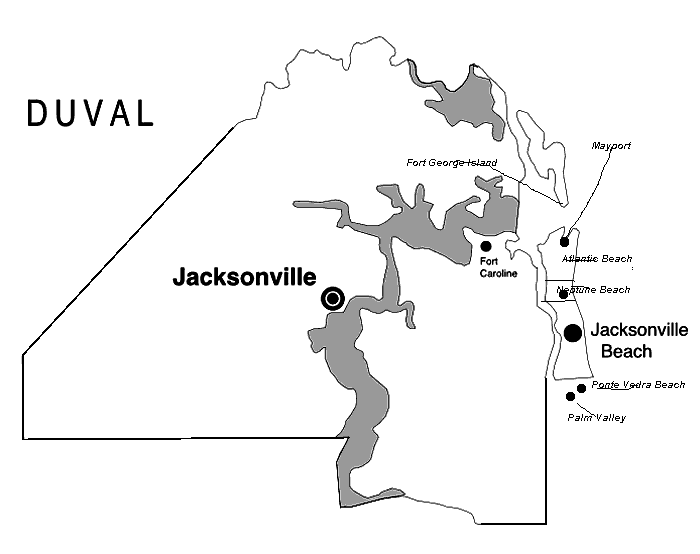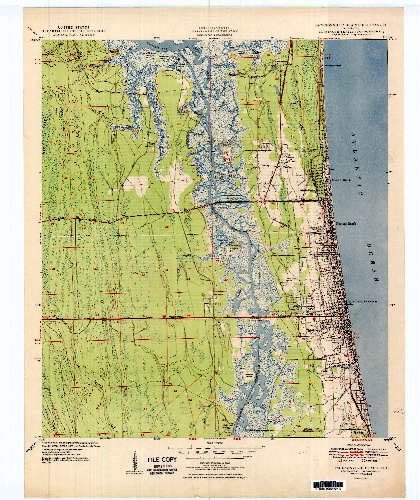|
Introduction
Preface to the 2005 Edition || 1: MAYPORT
by
Donald J. Mabry
@ 2005 Donald J. Mabry
Ed Smith wrote for family and friends when he penned
nostalgic essays about life on "Mayport and the Beaches," communities
on the northern end of a
narrow barrier island off the coast of Jacksonville, Florida. Although the
essays are pleasant reads for those who know the area and even more so for those
who knew the people, providing background on the places and people makes his
book more valuable as a glimpse into life in what was a backwater in the first
half of the twentieth century. Few today would recognize the area about
which Ed Smith wrote. Higher incomes, cheap air conditioning, better and more
divided highways, the dramatic expansion of the Mayport
Naval Station into the second largest naval installation on the U.S.
Atlantic coast, and the growth on Jacksonville into a megalopolis of more than
one million people, the sprawl of housing developments, and the destruction of
historic housing for the benefit of condominiums in the thirty-two years since
he wrote his book in 1973 make Mayport and the beaches almost unrecognizable.
Only the Atlantic Ocean, Pablo Creek/San Pablo River1,
and the St. Johns River seem constant. This outline map of Duval County, Florida shows the
geographical relationship of these communities. Ponte Vedra Beach and Palm
Valley are in neighboring St. Johns County.

In the 19th century and the early years of the 20th, the
island was relatively isolated and very sparsely populated. The northern
boundary is
the St. Johns River. To the east is the Atlantic Ocean. To the west, are rivers
such as Pablo Creek/River and the Tolomato River plus a canal through the Diego
Plains connecting the two. On the south, near Vilano Beach, the Tolomato River
enters the Atlantic. The island is now tied to the mainland by a number of
bridges and one can easily forget that one is going onto an island for the width of
the waterways is not that great. The communities on the northern
end of the island, the subject of the book, are Mayport, Atlantic Beach, Neptune Beach, and Jacksonville
Beach in Duval County and Palm Valley and Ponte Vedra Beach2 in
adjacent St. Johns County. Mayport, the oldest settlement, was considered as a
separate community until Jacksonville became synonymous with Duval County.3
Both Ponte Vedra Beach and Palm Valley are unincorporated
communities in St. Johns County.
This topographical map of the Beaches area shows
that the area was largely sand dunes, swamps, marshlands, and creeks with only a
narrow band of development as late as 1949. The village of Mayport and the Naval
station are not shown on this map. They are located north of the area shown.
Similarly, only the northern tip of the Ponte Vedra Beach-Palm Valley area are
shown in the lower right hand side.

Click on the map to enlarge it
Living on a remote barrier island off the coast of
Jacksonville in North Florida in the late 19th and early 20th centuries had to
be tough, even for people accustomed to hardship. The best route to
Jacksonville was traveling on the hard-packed beach at low tide to Mayport and
hen by boat or ship up the St Johns River. Getting to
Mayport was a two hour trip on the and then getting to
Jacksonville was a three-hour trip upriver. Still, it was easier than
going due west for 15 or miles at least the river provided smooth
passage.
Settlement clustered in the fishing village of Mayport, originally
founded by
French Huguenots in the 16th century. In addition to fishing and a little
farming, people and
goods coming or going to Jacksonville or could be offloaded there. The village
contained about 600 people in 1864. Entrepreneurs
tried to develop a tourist trade by building a few hotels on Burnside Beach on
the coast but fire destroyed their dreams so the area remained small. Not
until the U.S. Navy decided to build a naval base on Ribault Bay did Mayport
change.
Jacksonville Beach had better luck because a narrow gauge railroad
ran from
south Jacksonville to Pablo in 1886. Eventually two railroads ran
east from Jacksonville—one to Mayport, the other to Jacksonville Beach. That drew
a few people, many of whom lived in tents. That was the situation of William E.
and Eleanor Scull in 1884. She was the postmistress of the Ruby Beach Post
Office named after their daughter. They lived in one tent and ran a store
and post office from the other tent. A resort hotel, the Murray
Hall, was built in 1886 but it lost money and was destroyed by fire in 1890. Then, in 1900, Henry Flagler,
Standard Oil magnate and railroad builder, acquired the Jacksonville Beach
route, eventually extending it to Mayport. He Flagler built the luxurious Continental
Hotel in Atlantic Beach in an effort to build tourism. Like other hotels at the beaches,
it was destroyed by fire. The railroad was removed in 1932 because automobiles
and trucks made it redundant. Although the opening of Atlantic Beach Boulevard, paved with
shells, in 1910 from
south Jacksonville made access to the island easier, few people owned cars. The automobile age
which began in the 1920s would kill the railroad. As George Simons notes, 116,000 cars
were registered in Florida in 1922, 286,000 in 1925, and 460,900 by 1942. The St
Johns River was spanned in 1921 and Atlantic Boulevard was modernized as a
paved road in 1925.4
Still, few people moved to the island until the 1930s and
1940s. Pablo Beach had only
249 inhabitants in 1910, 357 in 1920, and 409 in 1930.5 In spite of
the Great Depression and the loss of Neptune Beach in 1931, Jacksonville Beach
grew to 1049 in 1935 and 3566 in 1940. Neptune Beach grew from 350 in 1935 to
1363 in 1940. Atlantic Beach contained only 164 people in 1930 and 468 in 1940. Palm Valley had only a few hearty pioneers.6
Mineral City was renamed Ponte Vedra Beach in 1928 but its
conversion to a luxury resort and residential area was slow.
The beaches did develop as a resort. Winter tourists went
further south but summer tourists from north Florida and south Georgia
flocked to the amusements along the
boardwalk in Jacksonville Beach and the sand throughout the beaches. Bath
houses, rooming houses, hotels, and, eventually, motels provided places to stay
for tourists and employment for the locals. A roller coaster, merry-go-rounds,
bumper cars, and other rides thrilled kids and adults. Restaurants and bars
satisfied basic needs. Although the main season lasted but five months, it
provided a living for those who didn't survive by commuting to Jacksonville or
fishing. The beaches were a satellite of Jacksonville and their fortunes were determined by it.
World War II changed the area. The riverport became a seaport.7 The U.S. Navy expanded and
built new bases. Navy personnel from Jacksonville came to the beaches for
recreation and some stayed but it was the Mayport Naval Base that made the
beaches area grow quickly in the 1940s and the 1950s as Mayport Naval Station
became an important aircraft carrier base. Government money flowed into all
manner of enterprises. Jacksonville Beach grew from 3,566 people in 1940 to
5,943 in 1945 to 6,430 in 1950 and 12,053 in 1960. By 1945, Atlantic Beach had
956 people and Neptune Beach had 1,298. Even so, the beaches area was a small
town in 1960 quite a distance from Jacksonville. Although there were two very
good highways and regular city bus service connecting the beaches and
Jacksonville, it was still insular. Even the many who commuted the 15-16 miles
into Jacksonville to work saw themselves as being different.
Jacksonville moved the town limits to the town limits of the beaches in 1968
as it and Duval County (save Atlantic, Neptune, and Jacksonville Beaches and the
west Duval town of Baldwin) became one. Now the San Pablo River became the
dividing line. As the national economy boomed in the 1960s, so, too, did that of
the Jacksonville area. Improvements in its shipping capabilities through
dredging of the St. Johns River and improvements in it port facilities had
dramatically increased its importance as a trade center. Prudential had
established its south central office there in the early 1950s, paving the way
for other financial institutions. People migrated to Florida, including
Jacksonville. The Vietnam War meant billions of dollars spent not only on
payrolls and improvements at Mayport, Jacksonville Naval Air Station, and Cecil
Field but also on civilian activities. By 1970, Jacksonville had
grown to 528,865 persons; Jacksonville Beach to
19,000; Atlantic Beach to 6,132; and Neptune Beach to 4,281. Ponte Vedra Beach
had expanded commensurately. Palm Valley, that swampy area on the Intracoastal
Canal, also grew. The area was bustling. The vacant land close to the water was
virtually gone.
No wonder, Smith, who had come to the beaches in 1936 when it
was possible to know almost everyone, at least by sight, wrote of the good old
days. He could just as easily of termed that period "the world we have
lost." Surprisingly, he was not bitter. Instead, he looked to the future
with promise.
1. The name of this body of water varies.
Pablo Creek, Pablo River, and the San Pablo River are the same. Since it forms
an important part of the Atlantic Intracoastal Waterway, residents have often
referred to it as the Intracoastal. In recent decades, residents sometimes refer
to it as "the ditch," as in, "they live on the other side of the
ditch."
2. Mineral City was
renamed Ponte Vedra Beach in 1928.
3.. Baldwin west of Jacksonville and Atlantic, Neptune, and Jacksonville Beaches have their own city governments and, thus, retain most of their autonomy but the City of
Jacksonville performs many governmental functions for them.
4. George W. Simons, Jr., Report for the
Jacksonville Beaches Chamber of Commerce, 1944.
5. Simons, p. 7; Beaches Area Historical Society, October 19, 2005
via e-mail; Sidney P. Johnston, The Historic Architectural Resources of the
Beaches Area: A Study of Atlantic Beach, Jacksonville Beach, and Neptune Beach.
ESI Report of Investigations No. 382, July, 2003, pp. 8, 45, 52, 58, 66, 70, and
73.
6. Michel Oesterreicher, Pioneer Family: Life on Florida's
20th-Century Frontier. Tuscaloosa: University of Alabama Press, 1996 details
)how her parents settled in Palm Valley.
7. George E. Buker, Jacksonville: Riverport-Seaport. Columbia: University of South Carolina Press, 1992.
|

